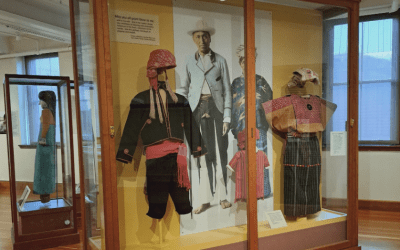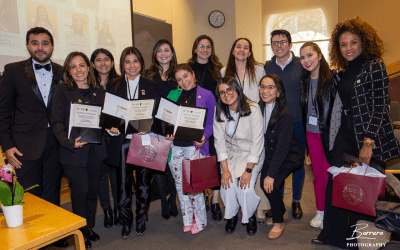
About the Author
Rina Rossi is a writer who studied Political Economy and Classics at UC Berkeley. She is half-Dominican, with roots in Santiago, Puerto Plata and Higüey. Rina will enter a graduate program this year focusing on Latin American studies, particularly reproductive justice and gender equity in the Caribbean.
Plátanos, manglares y cafecitos
The Dominican Republic and Puerto Rico during Hurricane Fiona
In September and October 2022, I traveled back to the Dominican Republic and Puerto Rico, the former my father’s home country where I had not visited since I was 13 in 2015. My father and I ended up in the Caribbean precisely when Hurricane Fiona hit.
“Rina, it’s your first hurricane!” my dad chuckled while patting my head.
While I never thought a hurricane was an event to add to my bucket list, I decided to trust my father’s experience with such natural disasters, since he had experienced about thirty Caribbean storms. Thus, we didn’t cancel our trip but decided to forego our ferry expedition from Puerto Rico to the Dominican Republic in favor of a plane ride. Arriving in Puerto Rico, I quickly became acquainted with the sounds of coqui frogs, rain and the generator running throughout the night. By the second day of our trip, we lost electricity and running water, but worked together with our family members whom we stayed with to keep everyone safe and dry. We installed a flashlight on the bathroom wall, stayed equipped with water bottles and used a hose to flush the toilet. Later that day, I met up with my second cousin and her mother to visit Old San Juan. Driving, rather than walking through the rainy colonial town, I saw multicolored shops and houses, pigeons and kittens walking about and interesting placards on various buildings, such as one that read, “La Casa donde nació La Piña Colada en el año 1963.” As a fan of pineapples, this was not a bad place to run into!
My cousin told me that the businesses in Old San Juan are encouraged to preserve their architecture in the colonial town’s style, as was evident in their near-identical exteriors, from the gelato shops and paint-and-sip studios to the hotels and apartments. We ended the day just before another rainstorm with a buffet by the pier.
Enamored with all of the beauty I had been surrounded by over the past few days, I posted a picture of one of the buildings from my excursion in Old San Juan to my Instagram account. Many people I knew from Berkeley and my hometown of Santa Cruz, California, were surprised to see that some businesses in the area had electricity and that I wasn’t drowning underwater from the storm. While I never expected to come back to my second home during a storm, it gave me a different perspective on living in the middle of a natural disaster and being able to verify the reality of the storm’s conditions and accessibility to basic resources.
Alas, I had seen just a small fraction of what Puerto Rico had to offer, but was in awe of the rich culture, history and people. Nevertheless, it was almost time to go and my father and I left for the Dominican Republic the next morning.
Arriving in Santo Domingo after just a 45-minute flight, memories from my last trip to the island in 2015 began to hit me and I could not wait to meet my tía’s (aunt’s) joyful face, as well as see the hyperactive chihuahuas and blooming jardín (garden) again. Sitting over a dinner of muchos plátanos (fried plantains), salad, rice and beans, my father spelled out some of the activities he had planned for us over the next week, which included going to cultural museums, visiting the Ciudad Colonial, attending a jazz show, going to the beach and watching his biologist friend present a lecture on manglares (mangroves). While I don’t have a favorite out of all the places we visited, going to the Centro León the next day—a cultural, historical, ecological and art museum in Santiago—was certainly one of the most eye-opening experiences of my trip.
- My tía’s chihuahua
- My tía’s jardín
Stopping by a Café Santo Domingo en route to the museum, my father bumped into an old friend he played music with in his youth, and we sipped on our cafecitos at a table next to a famous Dominican baseball player from the 1970s—classic small-town Dominican experience? It was wonderful seeing my father connect with so many good friends and family throughout the trip, and it happened over and over again.
When we finally arrived at the Centro León, we were greeted by a beautiful outdoor garden featuring young turtles and local plants. Inside the museum, there was a charming balance of light green and blue painted paraphernalia that made me feel like I was walking into Miles Davis’s “Blue in Green” translated to a physical place. We first entered an exhibit detailing the history of the León family who created the museum and founded La Aurora Cigars, as well as Grupo León Jimenes, which produces cigarettes and beer like Marlboro and Heineken in the Dominican Republic. The exhibit featured numerous pictures of the León family, advertisements throughout history about Marlboro and Heineken, and an exhibition with Presidente Beers moving across a conveyor belt.
The next exhibit we visited showcased the cultural history of Santiago, featuring pictures, videos and relics of cultural festivals, the wildlife in the city and artifacts belonging to the Taíno community. I enjoyed looking through the numerous drums, photographs of ordinary Dominicans in the latter half of the 20th century, and even random cultural artifacts like Tylenol from a couple of decades ago, while listening to the chanting of a marchanta (street vendor) as she explained what she was selling in an archived audio recording. I also greatly enjoyed that the museum included a Caribbean exhibit shedding light on the lesser-studied countries of the region, such as Surinam, Guyana and French Guiana. As a budding scholar of the Caribbean, I hope to direct interest and literature into areas that are often overlooked or excluded when considering Caribbean politics, history, art and literature, and I was glad that the Centro León incorporated countries in addition to the Dominican Republic in their Caribbean exhibition.
Sipping a cup of café whose beans were ground by my abuelo (grandfather) every morning, we were off to places like a bachata dance, mofongo restaurant, jazz show in Santiago and the Ciudad Colonial in Santo Domingo. The jazz show, located within the neighborhood where my father used to take French and music lessons, was organized by his friend who hosted jazz musicians in his bar every Monday for a weekly “Lunes de Jazz” event. As a jazz aficionado, I was love-struck by the live music and aura of the event. Local musicians came together to perform jazz, samba and bossa nova pieces such as “Garota de Ipanema,” “Satin Doll” and “Desafinado,” and invited audience members to share poetry and songs in the warm, humid night. Not only was “Lunes de Jazz” a night full of live jazz, but it was also an intimate cultural affair that allowed me to immerse myself in the art and music community of Santiago where my father grew up and blossomed as a flutist.

Pictured are my abuelo’s coffee beans

Pictured is a mofongo dish that I devoured

Pictured is a street from the Ciudad Colonial
Sadly, by this point of the trip, we only had a few days left. We spent the last two full days of our trip going to a botanical garden and visiting the beach in Puerto Plata, the city from which my father’s paternal side of the family is from. We went to the botanical garden in Santiago to hear my father’s biologist friend give a presentation about manglares with the Dominican environmental organization Grupo Jaragua. At the presentation, we were surrounded by picturesque photographs of manglares, birds, manatees, sharks and crabs. As someone who is passionate about the environment and marine life, I felt privileged to be in a room with so many wonderful scientists, photographers and environmentalists. However, I do draw the line at mosquitoes, as there were many of them at the botanical garden, and I quickly realized that I should have put on more bug spray after I poked fun at my father’s friend for spraying too much spray directly on his face.
“No…la cara es muy importante!” an employee at the garden sharply said as she scolded me.
I chuckled, but paid the price with my seven new mosquito bites upon leaving the presentation.
On the last day of the trip, my father and I finally made it to the beach at Puerto Plata, after a week of avoiding big waves and water from the storm. As a Californian, I was very familiar with beaches, but none could compare to the aquamarine waves, fresh lambí (Queen conch) dishes and viridescent ecology of the Dominican beaches. This particular beach was about an hour away from where we were staying in Santiago, and we took long mountain roads to get there. One such area in these mountain roads that we passed was the exact place where the Mirabal sisters were assassinated by secret police of the former dictator Rafael Trujillo. The Mirabal sisters were dissidents to Trujillo’s regime and their tragic assassination led the United Nations to memorialize November 25— the day of their deaths— as the International Day for the Elimination of Violence Against Women. Passing by the place where the sisters were assassinated was the most tragic part of my trip, but it allowed me to reflect and converse with my father about gender violence and the strong women in Dominican history who had fought for civil rights. I believe that having difficult and even uncomfortable conversations are paramount to creating social change. In fact, as a foreigner who is interested in studying Latin American politics and reproductive justice throughout the region, visiting the Dominican Republic and having conversations with citizens about additional aspects that complicate these issues, such as colorism, poverty and corruption, was crucial to shaping my perspective on how these social problems should be dealt with.
Driving back to Santiago for my last night on the island, my father paved through the same mountain paths we had taken on our trip up. With bits and pieces of sand stuck between the crevices of my toes and the sweet, salty scent of the Caribbean still left in my hair, I was sad to leave so soon but eternally grateful for the beautiful experience I had with my family and friends.
Hasta luego, República Dominicana.
Con mucho amor, Rina
More Student Views
Fibers of the Past: Museums and Textiles
Every place has a unique landscape.
Río Piedras: As a Desert Flower Blooms in the Night
The sunset of my first day at the Harvard Puerto Rico Winter Institute (HPRWI) painted the sky with violet and magenta. It felt as if the day had just begun.
Colombian Women Who Empower Dreams
English + Español
The verraquera of Colombian women knows no bounds. This was the message left with me by the March 30 symposium, “Empowering Dreams: 1st symposium in honor to Colombian women at Harvard.”















